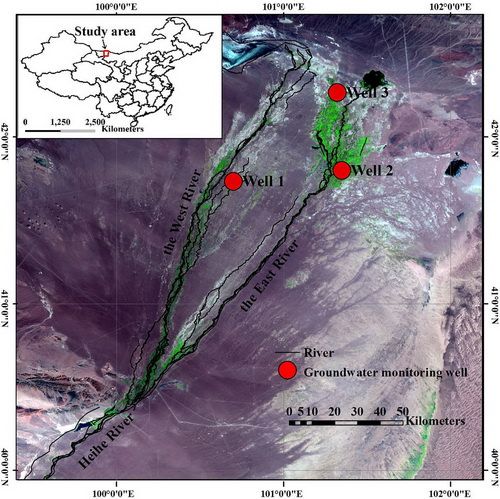Artificial Intelligence Models Assist to Forecast Groundwater Depth
Published on by Water Network Research, Official research team of The Water Network in Academic
Scientists used the wavelet-artificial neural network (WA-ANN) and wavelet-support vector regression ( WA-SVR), and picked an optimal artificial intelligence (AI) model to forecast the groundwater depth.
Groundwater is an important resource for arid and semi-arid regions and is significantly linked to ecological environments. Groundwater depth (GWD) influences the distribution of vegetation to affect salinization and land desertification. Therefore, prediction of the GWD is a critical task in water resources management.

Location of the study area and groundwater monitoring wells (Image by WEN Xiaohu), Source CAS
Recently, a research group from the Key Laboratory of Eco-hydrology of Inland River Basin, Northwest Institute of Eco-Environment and Resources of the Chinese Academy of Sciences, together with their colleague from Australia, investigated the three different observation wells in different months in the Ejina Basin.
They used the wavelet-artificial neural network (WA-ANN) and wavelet-support vector regression (WA-SVR), and picked an optimal artificial intelligence (AI) model to forecast the groundwater depth.
Scientists decomposed groundwater depth and meteorological inputs into approximations using discrete wavelet transform, and embedded detail with predictive features in high frequency and low frequency.
The results show that the support vector regression (SVR) model performed slightly better than the artificial neural network (ANN) models.
Furthermore, between wavelet based models, the WA-SVR performed better than WA-ANN model. That is to say, SVR was superior to the ANN model.
Therefore, the study indicates that WA-SVR could be applied for groundwater forecasting under ecological water conveyance conditions.
The objective of this research is to investigate whether wavelet hybrid models capture dynamical changes in GWD under the water conveyance, which is a pressing issue for water resources management.
The novelty of this study is to develop for the first time, a set of hybrid artificial intelligent models for the prediction of GWD with a central aim to better understand the influences of the ecological water conveyance project in the Ejina Basin.
This research has been published in the Water Resources Management in an article entitled "Comparative Study of Hybrid-Wavelet Artificial Intelligence Models for Monthly Groundwater Depth Forecasting in Extreme Arid Regions, Northwest China".
Source: Chinese Academy of Sciences

Image source: Max Pixel
Media
Taxonomy
- Water Resource Management
- Groundwater
- Water Resource Management
- Groundwater Recharge
- Groundwater Assessment
- Groundwater Modeling
- Groundwater Mapping
- Groundwater Resource
- Water Software
- Data & Analysis